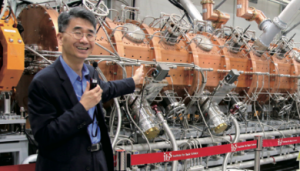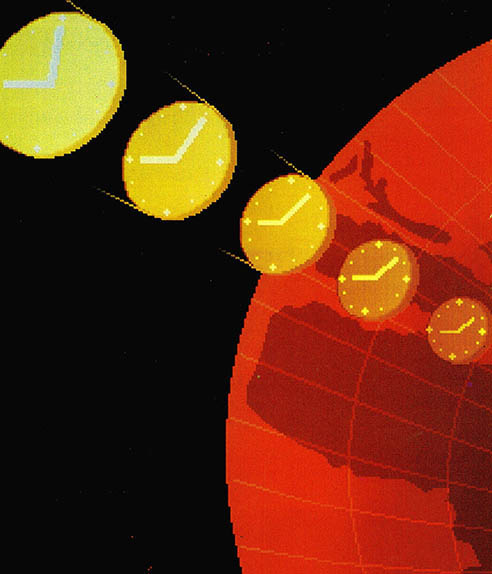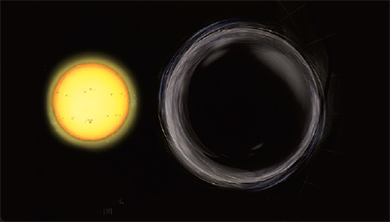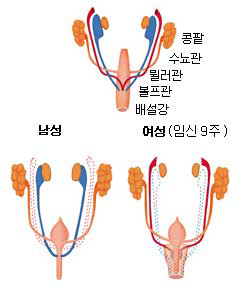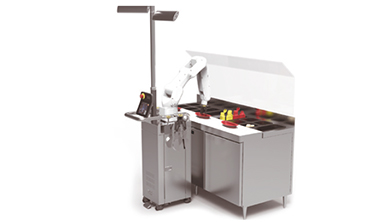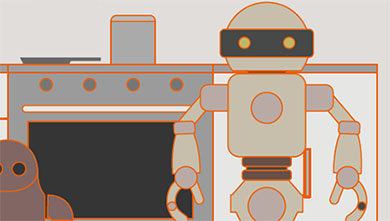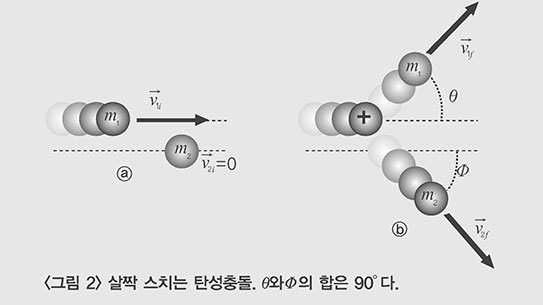우리 생명은 필연적으로 태양천문학자들이 부르는바 소위 '태양과 지구의 접촉'에 영향을 받지만 대부분의 사람들은 빛외에 태양으로부터 나오는 다른 모든 것에 대해선 아무 것도 아는 바가 없다. 빛의 스펙트럼상 자외선 부분은 우리 살갗을 태우고 피부암을 발생시키는 원인이 되면서도 우리 눈엔 보이질 않는다. 우린 스펙트럼상의 그 반대부분으로 빛의 60%를 차지하는 적외선 또한 보지 못한다. 그러나 태양은 빛뿐만 아니라 X선과 대전입자들과 중성미자들도 발한다.
대전입자들은 속칭 태양바람 속으로부터 퍼져나와 3일 반 만에 지구에 도달한다. 극심한 태양면 폭발이 있는 동안 태양바람은 태양폭풍이라 불리는 위험수위로 맹렬해 진다.
태양바람의 힘이 거세지면 지구의 위도상 낮은 곳에선 북쪽으로부터 비추는 아름다운 빛인 북극광이 발견된다. 태양흑점의 변동으로 인한 지구자장의 이변인 자기폭풍이 중요한 인공위성들의 위치를 바꾸고 캐나다 퀘백지역에서 정전사태를 발생시킨 지난 1989년 이후부터 과학자들은 그같은 폭풍을 예측하는데 보다 정확성을 기하고자 많은 노력을 기울여 왔다. 현재까지 알려진바 가장 좋은 방법은 태양의 코로나를 관측해 코로나의 부분들이 공중으로 찢겨나가 태양폭풍을 거세게 만드는 것을 확인하는 것이다.
우리의 궁극적인 미래는 우주의 탐험과 개척에 있는 까닭에 우린 태양바람에 관해 가능한한 많이 알아야 한다. 태양표면에너지프로그램(STEP)은 많은 천문대와 인공위성들과 컴퓨터 모의실험으로부터 얻은 결과들을 조정하는 7년짜리 연구과제다. 태양은 시간에 따라 변화하기 때문에 태양으로부터 나오는 것도 다르며 지구와 접촉 하면서 전달해오는 태양열도 변한다. 이 모든 태양바람의 변화상은 관측되고 측정돼야만 한다.
태양바람의 연구는 과학자들로 하여금 다른 별들을 이해하는데도 도움을 준다. 태양바람같은 이온화된 가스가 우주의 현재까지 알려진 대부분의 물체를 형성하고 있으므로 우주 그 자체를 이해하는 것도 쉬워질 것이다.
태양으로부터 나오는 입자중 하나는 매우 작으면서도 언제나 큰 수수께끼인 중성미자다. 과거 과학자들은 태양으로부터 나오는 많은 양의 중성미자가 아마도 태양내에서 진행중인 핵융합의 정확한 척도이리라고 믿었다.
25년 전에 태양으로부터 나온 중성미자의 수가 처음 세어졌을 때 과학자들은 태양과 같은 주요 별들이 운동하리라고 상정한 '표준모형'이 기대하는 수보다 너무 적음에 놀라고 말았다. 이에 과학자들은 그 표준모형이 이제 쓸모없다는 말인가 하고 걱정하기에 이르렀다. 여기엔 세가지 가능성이 존재하는 것처럼 보였다.
(1) 중성미자들은 태양의 양성자와 양성자간의 융합 반응으로 실제론 대량으로 만들어지지 않는다.
(2) 중성미자들은 기대하는 만큼 대량으로 생산되지만 지구에 도착하는 동안 무슨 일인가 발생해 그중 소수만이 숫자로 헤아려질 수 있다.
(3) 태양중심부의 핵융합이 만드는 에너지는 생각했던 것보다 효율적일는지 모른다. 이는 태양중심부의 온도가 더 낮음을 의미하고 따라서 적은 숫자의 중성미자만을 허용함을 뜻한다(이 이론은 심한 논쟁을 불러 일으켰다).
태양중심부의 양성자와 양성자간의 핵융합반응은 전자중성미자를 생산하는데 고에너지와 저에너지라는 두 속도로 나타난다. 올해까지만 해도 '중성미자탐지기'들 은 고에너지 중성미자만 등록시킬 수 있었다. 1960년대에 레이몬드 데이비스는 탄소 사염화물 탱크들을 지하에 묻었다. 새로운 프로젝트들은 갈륨탱크들을 등장시켰다. 그리고 최근 이중 하나의 갈륨탱크는 더욱 크게 만들어졌다. 바로 이 탱크는 저에너지 전자중성미자를 찾았는데 그러나 아직도 만족스럽지는 못하다. 물리학적인 브라운 대학의 밴들러는 저에너지 중성미자를 더 많이 찾기 위해 실리콘(규소)웨이퍼와 초유동 헬륨액체로 만들어진 새로운 탐지기를 제안했다.
중성미자에 관한 또 하나의 이론이 흥미를 끌고 있다. 이 이론은 MSW이론이라 불리는데 소련과 미국과학자들인 스타니슬라브 미케이예프, 알렉시 스미르노프 그리고 링컨 월펜스타인의 이름에서 딴 것이다. 이들의 이론에 따르면 태양의 핵반응은 충분한 중성미자를 생산하지만 이 중성미자들은 세가지 형태로 진동한다. 이미 잘 알려졌고 측정까지 된 전자중성미자와 오로지 실험실 내에서만 발견되는 뮤온과 타우온이 그들이다.
만약 MSW이론이 맞고 전자중성미자가그 형태를 변형한다면 태양의 핵융합에 관한 표준이론들을 입증할만 한 충분한 중성미자들이 실제 존재하지만 이 전자중성미자들이 지구에 도달하는 동안 그 형태가 바뀌기 때문에 우리가 기대하는 형태로 볼 수 없는 것 뿐이다. 문제는 그렇다면 태양뮤온과 타우온을 찾아내는 탐지기를 개발하는 것이다.
만약 과학자들이 이 세가지 형태 사이에서 중성미자들의 변화함을 증명할 수만 있다면 그 변화는 중성미자들이 어떠한 질량이든 조금이라도 갖고 있음을 시사하는 셈이 된다. 그렇다면 우주학은 갑자기 활기를 띄게 될 것이리라! 아주 많고 많은 중성미자들이 우리 우주 모든 은하 계속의 엄청난 수에 달하는 별들에서 쏟아져나오기 때문이다.
한편 그러한 중성미자들이 완벽하게 무질량이라면 우린 우주에 관한 매우 원론적인 질문에 대해 답을 찾아야만 한다. "우주는 언제 끝날까?"가 바로 그것이다. 아주 미약하나마 '질량있는' 중성미자들이 많고많다면 우주의 '기본주요질량'을 형성해 언젠가 파괴되고 말 것임을 보장하기 때문이다.
그렇기만 하다면 빅뱅(대폭발) 가설은 다시 시작될 수 있을텐데 말이다.
Our lives are inevitably affected by what solar astronomers call the "Sun-Earth Interfece," but most humans are not aware of anything coming out of the sun except light. The ultraviolet side of the spectrum of light is invisible to us, even as it gives us sunburns and skin cancer. We also can't see infrared, the 60 percent of light at the other end of the spectrum. The sun, however, emits not only light but X-rays, charged particles and neutrinos.
Charged particles zoom out of the sun in what's called the solar wind, reaching Earth in three and a half days. During intense solar flare activity, the solar wind can increase to the dangerous levels we call a solar storm.
When the solar wind strength is up, lower latitudes of Earth witness the aurora borealis, the beautiful northern lights. Since 1989, when magnetic storms displaced important satellites and knocked out power to Quebec, scientists have tried very hard to improve prediction of such storms. The best bet right now is to monitor the solar corona, noticing when masses of it tear away into space and increase the solar wind.
Because our ultimate future may depend on space exploration and settlement, we must learn as much as possible about the solar wind. STEP-(Solar-Terrestrial Energy Program) is a seven-year project coordinating research results from observatories, satellites and computer simulations. Since the sun changes from moment to moment, so does what comes out of it, changing the transfer of solar energy in the interface with Earth. All these variations in the solar wind must be observed and measured.
Studying the solar wind also helps scientists understand other stars. The universe itself may become easier to understand, for ionized gases like the solar wind apparently constitute most of the known matter in the universe.
One particle coming out of the sun is the neutral neutrino, a tiny object but a perennially big puzzle. In the past, scientists believed that the flood of neutrinos from the sun was an exact measure of the nuclear fusion presumably going on inside the sun.
Twenty-five years ago, when solar neutrinos were first counted, scientists were startled to find fewer than had been expected from the "standard model" theories about how main sequence stars like the sun work. Scientists worried that the standard model would have to be discarded. There seemed to be three possibilities:
(1) Neutrinos may not actually be produced in big quantities by the sun's proton-proton fusion reaction.
(2) Neutrinos may be produced in the expected big quantities but only a few can be counted because on their way to Earth something happens to them.
(3) The energy produced by nuclear fusion in the sun's core may somehow be more efficient than was thought. This would mean a lower temperature at the core, which permits lower numbers of neutrinos (This theory has been hotly debated.)
Proton-proton fusion reactions in the sun's core produce the electron neutrino, which comes in two speeds-high and low energy. Until this year, "neutrino detectors" could register only high energy neutrinos. Raymond Davis, in the '60s, used tanks of carbon tetrachloride placed deep in mines. Newer projects featured tanks of gallium. One of the gallium tanks has recently been increased in size. This tank has found some low-energy electron neutrinos, but still not enough. Physicist S. Bandler at Brown University proposes a new detector made of silicon wafers plus superfluid liquid helium, to find more of the low-energy neutrinos.
Another theory of neutrinos is attracting attention. The "M. S. W." theory is named for the Russian and American scientists Stanislav P. Mikheyev, Alexi Smirnov and Lincoln Wolfen-stein. According to their theory, solar nuclear reactions produce enough neutrinos, but they oscillate between three forms of neutrino : the known and measured electron neutrino, and the muon and tauon, found only in laboratory experiments.
If the M. S. W. theory is correct and electron neutrinos do change form, there may actually be enough solar neutrinos to confirm standard theories about solar fusion, but we can't see the expected form because somehow the electron neutrinos have changed form on the way to Earth. The problem is to build a detector that will find the solar muon and tauon neutrinos.
If scientists do prove that there is oscillation between the three forms of neutrino, such change of form would indicate that neutrinos possess some mass. Cosmology will be galvanized! There are so MANY neutrinos, coming out of the huge number of stars in all the galaxies of our universe.
If those neutrinos aren't totally weightless, we may have the answer to a fundamental question about the universe-how will it end? Umpteen megabillions of slightly "weighty" neutrinos would provide enough "critical mass" in the universe to ensure its eventual collapse.
Then the whole Big Bang scenario can start all over again!








